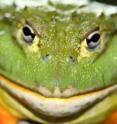Killer fungus threatening amphibians
Amphibians like frogs and toads have existed for 360 million years and survived when the dinosaurs didn't, but a new aquatic fungus is threatening to make many of them extinct, according to an article in the November issue of Microbiology Today. The fungus, Batrachochytrium dendrobatidis (Bd), was found to be associated with waves of amphibian extinctions in Central America and north-eastern Australia in the 1990's. Bd infects over 350 amphibian species by penetrating their skin, but little else is known about where it came from and how it causes disease.
The earliest published record of Bd is from a specimen of an African clawed frog in 1938 from South Africa. Around this time there was a huge trade in clawed frogs when they were used in one of the earliest human pregnancy tests. The global exportation of the clawed frog is likely to have spread Bd around the world. The infection is spread by fungal spores released into the water supply from imported infected animals.
Researchers are trying different approaches to treat existing Bd infection. Some are treating tadpoles with antifungal drugs, whilst more innovative approaches involve introducing 'probiotic' bacteria that naturally secrete antifungal compounds which kill Bd on amphibians' skin. To help limit the spread of infection, the World Organization for Animal Health (WOAH) now recommends screening imported amphibians for presence of Bd.
Source: Society for General Microbiology
Other sources
- Killer fungus threatening amphibiansfrom Science DailyTue, 24 Nov 2009, 19:21:44 UTC
- Water fungus threatens frogsfrom Science AlertTue, 24 Nov 2009, 13:21:10 UTC
- Killer fungus threatening amphibiansfrom PhysorgMon, 23 Nov 2009, 16:49:15 UTC
- Killer fungus threatening amphibiansfrom Science BlogMon, 23 Nov 2009, 16:28:56 UTC
